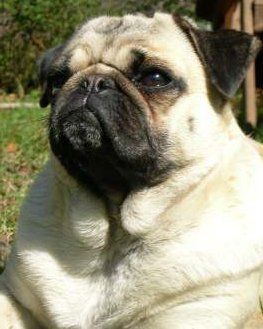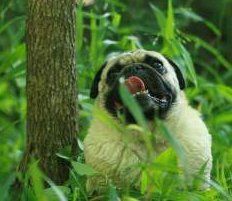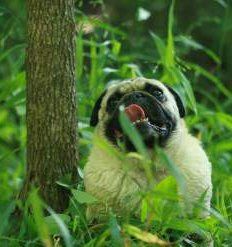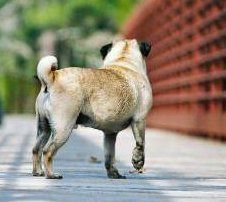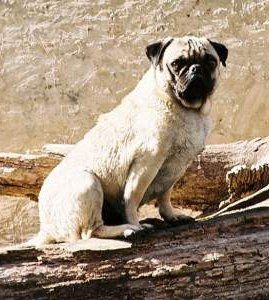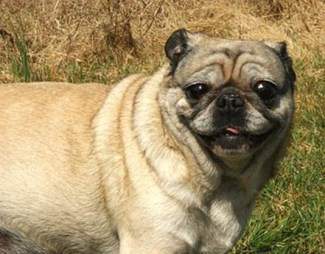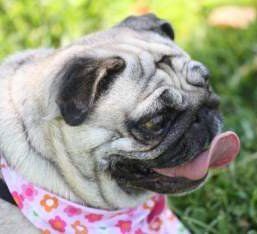Senior Pug Dogs
Overview
If you have an older Pug, it just seems like yesterday when he or she was a hyper little puppy, right? Or perhaps you just adopted an older Pug who needed a loving home. Our Pugs grow up so very fast, and of course you want to give them the very best of care.
Many elements of proper Pug care change when your Pug becomes a “senior”.
Toy breed dogs become seniors sooner than larger dogs. When will your dog be considered a senior Pug?
While veterinarians may vary their opinions by a year or so in either direction; it's safe to say a Pug is considered a “senior” by the age of 9 years old.
So, what can you do to make sure that the correct care is being given? What changes do you have to make to keep your Pug healthy and happy? You may be surprised. Let’s take a look at:
- What a Geriatric screening is all about
- Changes in your Pug that you must keep an eye out for
- Why Anesthesia needs change for an older Pug
- Dental Care
- Exercise Changes
- Grooming the older Pug
- Mobility Issues
- Food & Water
- Supplements for a senior Pug
- Vaccination information
Please note: PetPugDog is reader-supported, and some of the product suggestions on this page may be affiliate links. As an Amazon Associate we earn from qualifying purchases. This is at no extra cost to you and helps keep this site running.
What You Should Know About Geriatric Screenings
When your Pug is about 9 years old, he or she will have new experiences at the veterinarian. The vet will begin to do Geriatric Screenings. This means that additional tests will be added to regular checkups to look for any issues that may affect an older Pug.
In general, a geriatric screening of your dog will include: (1)
a thorough, hands-on physical exam; (2)
blood tests; (3)
possibly an electrocardiogram; (4)
specialized tests depending on your dog's health history.
Some vets advise semi-annual visits once your dog becomes a senior. An annual visit is an absolute minimum. In between visits to the vet and annual geriatric screenings, you can stay alert to behavioral changes and other signs of aging.
Physical and Clinical Signs to Watch Out for With an Older Pug
• Sudden weight loss can be extremely serious. Take your dog to the vet as soon as possible.
• Serious loss of appetite to the point that your Pug is eating almost nothing. See your vet right away.
• Increase in appetite without increase in weight may mean diabetes. Get to the vet as soon as possible.
• Chronic constipation or diarrhea
and vomiting, if it lasts more than a day can be a sign of many problems. Don't wait to see the vet.
• Increased thirst, without a change in activity level, and increased urination are other signs of diabetes. Your dog should be tested as soon as possible.
• Tiring more quickly than when younger is normal as a dog ages, but may also be a sign of disease affecting the heart or lungs. Be alert to your dog's becoming excessively out of breath after minimal exercise. Have your vet check for cardio-pulmonary problems as soon as possible, if you notice such symptoms. If the vet determines all is normal, you can continue an exercise program, but modify it in order not to overtax your dog.
• While this breed is known for having some breathing issues, coughing and excessive panting may indicate heart disease. If these symptoms persist even after you've modified your dog's exercise program, visit the vet.
• Difficulty in getting up from a lying position, or other problems with moving may indicate arthritis. Your vet will be able to advise you on ways you can relieve your dog's discomfort and lack of mobility.
• Problems with vision and hearing are natural as a dog ages. Accommodate these changes as best you can -- by not changing the location of furniture, for example, or clapping instead of calling your dog's name if he appears to have trouble hearing you.
• Graying hair and drying skin are sure signs of aging. More attention to grooming and the introduction of massage will help the condition of the skin and coat. Moderate to severe hair loss
and peeling, red or irritated skin problems are not normal and should be treated asap.
Behavioral Changes in an Older Pug May Include:
- Separation Anxiety- You may note that when you leave your older dog alone, he become destructive or barks or whines or loses control of elimination
- Sensitivity to noise- Thunderstorms that never bothered him before may now make your older dog tremble
- Vocalizing - This may be due to loss of hearing or to separation anxiety
- Uncharacteristic aggression.- This may be due to painful joints, a drug reaction, or intolerance for new people and new circumstances; your older dog likes things to remain the same
- Confusion, lack of attentiveness, disorientation.
- Roaming in circles, barking at nothing, being withdrawn....
- Elimination accidents
If your dog is acting abnormally
in any of the above ways, consult your vet right away.
Anesthesia for Senior Dogs
There's always a risk when your dog must undergo a procedure that involves anesthesia. If your vet says your Pug needs anesthesia, be certain the office is fully equipped with anesthetic monitors:
- A pulse oximeter
- Blood pressure monitor
- ECG
A "pulse oximeter" is particularly important because it alerts the vet if a dog’s blood oxygen level falls below the safe limit. One type of anesthesia that is recommended for older dogs is "isoflurane," an inhalation-type anesthesia that is quickly eliminated from the dog's body once inhalation stops.
However, Tufts University School of Veterinary Medicine reports that a new injectable anesthetic, "propofol" (brand name "Rapinovet," marketed by Mallinckrodt Veterinary, Inc.) has been shown to be less risky because it is eliminated even more quickly from the dog's body. We quote: " . . . dogs show less residual grogginess and irritability when recovering from propofol . . ."
Older dogs are generally at greater risk than younger dogs when anesthesia is administered, so this new anesthetic may be the best for an older dog.
Dental Care for the Older Pug
Dental care needs to be continuous from the time a dog is young. By the time a dog is "geriatric," the effects of dental neglect will be evident and potentially life-shortening. Rotting teeth can cause gum and mouth infections, and these infections can migrate to the vital organs and cause serious damage.
Gum (periodontal) disease is extremely common in older Pugs, and one of the more serious health problems that can occur. Basically it is the overwhelming presence of bacteria in the plaque that adheres to a dog's teeth.
Ideally, from a young age, a Pug will have access to chew toys and crunchy foods. In addition, your dog's teeth should be cleaned on a regular basis by your vet. But the most important element in keeping your Pug’s teeth and gums healthy is your brushing your dog's teeth regularly -- every other day or a minimum of three times a week.
By brushing regularly, you can also lengthen the time between professional cleanings by the vet. Dental care should consist of using a quality canine toothpaste and properly sized canine toothbrush.
Here's one technique for brushing your dog's teeth: Hold the mouth closed gently. Slide the brush in under the lips and along the teeth, toward the molars. Spend most of the brushing time on the molars, and do what you can with the other teeth. It's not necessary to open your Pug’s mouth to brush the inside surfaces of the teeth.
Don't give up if it doesn't work so smoothly the first time. And try different techniques if the suggested one doesn't suit your Pug. By experimenting, you and your Pug will learn how to cooperate to get the job done.
As a Pug ages, he gets lazier about chewing his food and playing with chew toys. He may develop a preference for softer food.
He may give only a few half-hearted nudges to the toys and treats he once gnawed on happily for hours. A gradually diminishing interest in chewing is normal as a dog ages; but if your Pug stops chewing suddenly or looks like he is eating in a "careful" way, it may be a sign that his teeth and gums are hurting and need professional attention.
Have your vet check your older Pug’s teeth regularly; but do it immediately if you notice a sudden change in his chewing or eating behavior. If your vet recommends that your dog's teeth be cleaned under anesthesia, you should be informed about the risks.
Alternatively, some vets will clean an older (mellower) dog's teeth using an ultrasound scaler, a mild sedative, and a "sack" type of restraint. But this may not be possible, even with a mellow dog, if there is serious gum disease.
Encourage chewing behavior as best you can: a new crunchy biscuit might work, or a new chew toy. Some of the rope "flossing" toys on the market are also often recommended by veterinarians. Most vets agree, however, that brushing is the most effective means of keeping your dog's teeth and gums healthy in between professional cleanings.
Exercise Changes for Senior Pugs
Exercise is as essential to dogs as it is to humans. It is profoundly tied to a dog's physical, mental, and emotional health. A sedentary dog is a bored dog, often an overweight dog, and, in general, a less-than-optimally-healthy dog. In older Pugs, obesity is the most common condition that vets see, and lack of exercise is a critical component of it.
As dogs age, they still need their exercise to benefit their heart, lungs, circulation, digestive system, and joints -- as well as to fight obesity. Compared with younger dogs, however, older dogs need to adjust the type and duration of the exercise they do.
Every dog is different in the way he or she ages and the exercise he or she can handle. You really need to be very observant in assessing your particular Pug’s abilities, natural inclinations, and current state of health. Keep alert to your dog's being excessively out of breath, or to a drooping head and tail. If your Pug coughs or does not get her breath back after five minutes of rest following exercise, have the vet check her heart.
In fact, if your dog is over 7 and has not had a check-up including a geriatric screening for more than six months and she has not been exercising regularly, get the check-up before beginning an exercise program.
Keep in mind that in general small dogs - even younger ones - aren't meant for distance running (therefore, it's not a good idea to take your Pug jogging with you).
Other basics to keep in mind: It's best to exercise your dog before he eats and to wait about half an hour after the exercise session before giving a meal. Keep your older Pug out of the sun, and, on a hot day, it's probably best not to exercise outdoors at all. Very cold, wet days are also times when indoor exercise is more appropriate.
If your Pug has been diagnosed with hip dysplasia, usually walking is still the best activity. For walking, use a harness so that you can control the duration and strenuousness of the exercise.
Two shorter walks will be less stressful on aging joints than one long walk. The walks can be quite brisk, provided the vet has given approval. A brisk walk should have four components:
• a warm-up of about 5 minutes, gradually increasing the pace
• brisk walking of about 20 minutes
• a cool-down of about 5 minutes, during which you gradually decrease the pace
• a drink of water.
If you play fetch with your older Pug, throw the ball or toy a little closer than you did when your dog was younger, and repeat the toss fewer times. After a point, it is probably advisable to stop playing fetch and to concentrate on walking.
Keep in mind that your Pug will do anything to please you. That will mean he may tend to become over-exerted in running or playing simply because he thinks that's what you expect. You will need to judge carefully and to adjust the strenuousness and duration of the exercise accordingly.
Grooming an Older Pug Dog
The coat and skin are the dog's first line of defense against environmental attack - from such enemies as fleas, wetness, and cold. When the coat and skin are in poor condition, your dog becomes susceptible to disease or illness.
An older coat and older skin just can't take care of themselves like they used to - because circulation and muscle tone aren't as good as they were when a Pug was younger. You can make up for the decrease in these functions with a grooming routine.
Brushing
A daily grooming session with the proper tools is the first step. Brush and flea comb are two of the basics.
Fifteen minutes is usually all it will take each day, but those fifteen minutes will save you time in the long run. You'll keep your Pug’s overall health at a high level, helping to eliminate visits to the vet other than for regular check-ups.
Another reason for daily grooming
has to do with an aging Pug’s need for physical contact and attention. While puppies and young dogs are busy running around and finding a play thing in everything, an older Pug doesn't have energy for such things. A grooming session can be an interesting diversion for a dog. It is also an opportunity for you and your Pug to have a bonding experience, which is always a mood booster.
Baths
Though your Pug may be less active as a senior and therefore perhaps get less dirty, it is still important to stay on track with baths. There are two reasons for this.
First, the main purpose of baths is to remove excess body oils; these accumulate naturally and can start to smell
at the 3 week mark.
The second, is that if you use quality products, baths will serve to moisturize both skin and coat. Now, more than ever, the senior Pug needs warm water and an almost immediate move to a thick, absorbent towel right after bathing.
Use bath time to check your Pug's entire body for any lumps or bumps, and check for skin conditions. Run your hands over every area, including legs, ears, tail, underbelly, etc. Report any findings to your veterinarian ASAP.
Nail Changes that Can Occur
Trimming is usually done about every 3-4 weeks on a younger Pug, but an older Pug’s nails should be trimmed every three weeks. You can also do it weekly, if your preferred method is to trim just a tiny sliver from the nails each time you do it.
Younger dogs can wear down their nails a little with the running around they do, making it less necessary to be strict about the time between trimmings. But an older Pug tends to do less walking and running, so it's critical to keep to a regular nail trimming schedule. Nails that are too long can affect the dog's gait and cause imbalance and muscle strain.
The older your dog is, the more critical it is to keep the nails at the proper length, primarily so that the dog can maintain some semblance of a regular exercise program without compromising skeletal alignment and muscle function. A general guideline for proper length is that the dog's nails should not touch the ground when she is standing (i.e., not walking, but just standing still).
Mobility
An older Pug may have dealing with some hip problems, and by age 8 the majority of dogs have some degree of arthritis; and these issues will effect the level of a dog's mobility.
Traction
Many senior dogs need some help with gaining good traction, both in the house and out.
- If you have hardwood or other type floors which are causing your Pug to slip, place down skid-free runners.
- Use a quality paw wax, a recommended supply for a Pug of any age, to not only keep the paw skin from drying out
(it is not uncommon for cracks to develop either in between the toes or on the pads itself, which can be very painful and hard to treat once they have developed), but to also help with traction.
With a paw wax, you'll want something that absorbs quickly, allows the paws to breath and provides superior traction and protection. A good one to use is Musher's Secret Pet Paw Protection Wax .
.
Steps and Ramps
Of course, you can lift your Pug up, but to allow your dog to keep their independence, it is strongly suggested to have steps or ramps that allow your senior Pug to go up onto your bed, the sofa or any other safe area that his younger self normally jumped onto.
A good option for helping an older Pug is the Solvit PetSafe Stairs .
.
Neuter/Spay Surgery with a Senior Dog
Is it appropriate or beneficial to perform neuter or spay surgery on an older dog.? Studies point to it being beneficial unless a dog is extremely old or medically unstable. Females will endure heat cycles indefinitely, which can put stress on an aging dog. And while the health benefits including decreased risk of cancer are most notable when this is done with young puppies, it may be a good idea even with 'young' seniors in the 7, 8 or even 9 year old phase.
Spaying or neutering a senior Pug is a decision that always depends on a careful exam by a veterinarian, including bloodwork and other tests. If the exam shows a Pug to be healthy and in condition to successfully undergo the surgery, the pro's may outweigh the con's.
Loss of Appetite and Weight Loss Issues
A gradual loss of appetite is not uncommon in older Pugs. As a dog ages, his senses of smell and taste may decrease, making food generally less appealing. A sudden loss of appetite may mean the onset of a serious illness, so be sure to check with your vet if your dog refuses to eat for more than a day. Appetite that gradually diminishes to a dangerously low level also may be a sign of a serious problem. Again, check with your vet if you are in the least concerned about your
Pug not eating as much.
One way to increase the smell- and taste-appeal of food is to warm it. It is, in fact, recommended that you always present food to your Pug that is at room temperature rather than directly from the refrigerator. Take it from the refrigerator and bring it to room temperature quickly; that is, don't allow it to sit out for a lengthy period to warm up. Of course, it shouldn't so hot that it might burn delicate tissue in the mouth, either.
Some older Pugs like their food on the "soupy" side. Adding unsalted beef or chicken broth will make the meal easier for them to eat.
Treats for the Senior
While all training have long been done, older dogs appreciate treats now and then, just to let them know they're doing great.
The Pug breed is particularly sensitive to additives and chemicals that are found in some treats. And the senior Pug, even more so.
Stay away from hard pig ears or raw hides and stick with all-natural wholesome treats that are best for the Pug
breed.
You can always serve a bit of fresh or frozen fruit, which is high in water content, low in calories and offers immune boosting antioxidants.
Nutritional Supplements
There are a lot of canine nutritional supplements out on the market; some work very well and others not so much. For senior dogs, two are commonly prescribed by the vet, though you can obtain these yourself.
Some owners mistakenly believe that their dog has been prescribed medication, when in fact it is a supplement; so, your Pug may already be taking these. For this reason, you'll want to speak to your vet about these.
Here are some to consider:
• Glucosamine/chondroitin and/or MSM - For joint health. As a dog ages, the cushioning in his joints wears down faster than his body can renew it. This leads to osteoarthritis, seen in 80% of dogs age 8 and up, causing discomfort and mobility issues. A glucosamine supplement can help restore this, which can result in less pain and more function. Those with both glucosamine and chondrotin and/or MSM pack a pretty powerful punch to relieve issues.
Any Pug that has previously had joint or bone issues (broken bone, hip problems, patella issues, etc.) should already be taking this. And it is given to just about all senior dogs to help prevent or treat osteoarthritis.
While it is best to start a dog on this before his body has become depleted, it's never too late to start.
A recommended joint supplement for aging Pugs is Doggie Dailies Advanced Joint Supplement .
.
Other supplements that your vet may recommend include:
• Vitamin B-12 - for energy and metabolism
• Vitamin E - an antioxidant
• Vitamin C - may play a role in immune function
• Brewer's yeast - a good source of the B-complex vitamins
• Bromelain - aids digestion and is an anti-inflammatory
• Glycerin - for eye health
Hydration for Senior Pugs
The main problem with many older dogs is that they forget to drink, or, due to arthritis or joint pain, they have trouble getting up and moving around, so they avoid going to their water bowl. Dehydration -- even mild -- is a bad state for a senior dog.
The recommendations are: (1)
thoroughly wash and re-fill your dog's water bowl several times a day. (2)
Set out several water bowls in locations that your dog can reach easily. (3)
Deliver the water bowl to your dog if you notice he hasn't had a drink in a long time.
Be certain that the water you give your older dog is clean and free of pollutants. Because an older Pug’s kidneys may not be functioning as well as when he was younger, they won't tolerate impure water. Filtered water is always a great idea. Look to Pug Dog Supplies
for tips on how to offer toxin-free water and for choosing the right bowls.
Weather Related Issues for Seniors
Cold and dampness are hard on a senior Pug. As your Pug ages, his coat will get thinner and her circulation will be less efficient, making him feel the cold more. Protect him with a sweater and/or rain gear when necessary.
Older dogs are also more susceptible to becoming overheated in hot weather. Shade your older dog from the sun and keep him in an air-conditioned room in very hot weather. Take shorter rather than longer walks in the hot weather. Be sure he has plenty of cool water to drink.
When winter is upon us, we need to focus on the special needs of senior Pugs, that can be especially susceptible to the extremes of temperature and other stressful, dangerous conditions of winter.
(1)
Does your older Pug need a sweater? How about a raincoat? Wet fur decreases your dog's ability to fend off the cold. Even if she's never needed these before, as she gets older, she'll be less able to keep herself warm with activity.
(2)
Is your Pug’s sleeping area free from drafts? Is there a blanket and thick mattress pad for her to snuggle under/sleep on?
(3)
Protect the paws from ice melt chemicals. Stepping on the pebbles can cause chemical burns, but also stepping into puddles in which ice melt has melted can cause burns as well. Choose a quality paw wax and apply this every 3 days.
Good choices include:
One of the best paw waxes is Musher's Secret Pet Paw Protection Wax
 which is very effective while allowing the paws to 'breath'. This should be applied once every two weeks.
which is very effective while allowing the paws to 'breath'. This should be applied once every two weeks.
Companionship
An older dog tends to sleep more, but that doesn't mean he should be left alone more. His nose still tells him when he has human company, even as he naps on and off. He will still hear your voice (or sense your presence through vibrations), even though he looks like he's dreaming.
Give your older dog the benefit of as much human companionship as he's had throughout his life - even increase it, if possible. Keep him near you and take him with you when you go places. It will increase his sense of security and his involvement with his immediate world and give him quality of life.
Home Environment
In general, dogs like routine and don't often do well with major changes. Older dogs like for things to stay the same even more. To the extent possible, keep your Pug’s home environment and routines as they always have been. For example, his water and food bowls should be in the same location and he should be fed and walked at the usual times and in the usual places.
Of course, individual dogs will vary in their ability to deal with change in their surroundings. Dogs with decreased vision will be more stressed if the furniture is changed around than dogs whose vision is still good.
Be alert to signs of stress in your dog that you may have inadvertently caused by a change in home environment. Try to help her adjust by giving attention and guidance and lots of positive reinforcement when she seems to become more relaxed about the change.
Slippery floors of hardwood or laminate may become a problem as your dog ages. You'll notice that your Pug may begin to have trouble getting up from the bare floor, or walking across the bare floor. If so, cover the problem areas of the floor with a rubber-backed/non-skid runner or area rug.
Your older Pug's sleeping areas are particularly important environmental factors. Many older dogs - particularly those with arthritis in hips and back - seem to prefer sleeping on an "egg crate" type orthopedic mattress. Not only does it seem to provide a more even surface and therefore give better skeletal alignment, it also tends to reduce pressure on the dog's bony areas.
Vaccinations for Seniors
Annual Booster Shots Are No Longer the Preferred Protocol
Because the rate of illness due to vaccines has increased in pets (both dogs and cats), changes to vaccine protocols are being re-thought. The current protocol from Colorado State University advises vaccinations should be given only every 3 years (with the exception of rabies, which depends on state laws).
A quote from the protocol: "We are making this change after years of concern about the lack of scientific evidence to support the current practice of annual vaccination and the increasing documentation that over-vaccinating has been associated with harmful side effects"
What does this mean for your Pug?
Many vets feel that dogs over 10 or 12 years of age should not be vaccinated because their immune system can be compromised, and also, by the time they are seniors, they have received adequate protection. Some vets will not vaccinate dogs over the age of 7 or 8 years and some will alternate years. Each veterinarian will follow a schedule for seniors based on what he believes best.
One common thread, however, is that with most vets, a rabies shot will not be given at the same time as other vaccinations. It should be noted that the vaccines themselves carry the warning that they are to be administered only to healthy animals. Thus, if your senior Pug has any ailment or disease (e.g., cancer), vaccination should not be administered.
In some sections of the country, you can have your dog exempted even from rabies vaccinations by obtaining a letter from your veterinarian stating that your dog's health does not allow it.
If you are curious if your senior Pug has built up enough anti-bodes that shots are not needed any loner, it can be tricky to find the answer. There are blood tests that may detect the presence of antibodies to diseases however the test is not 100% reliable. A low level of antibodies does not necessary mean that a dog is not protected. And the test itself can show different results with one blood specimen.


